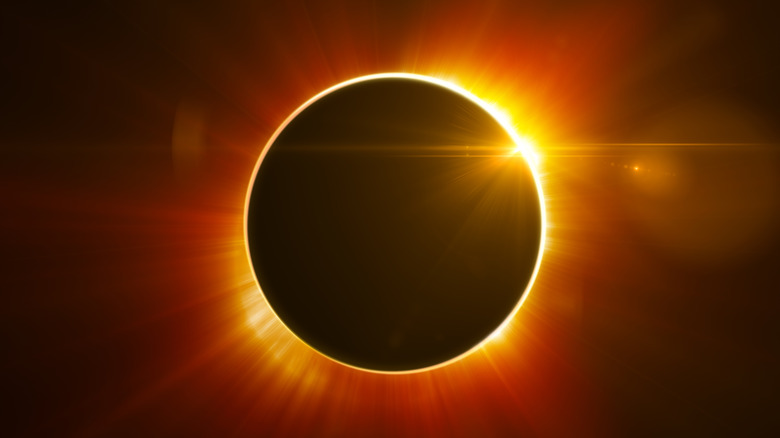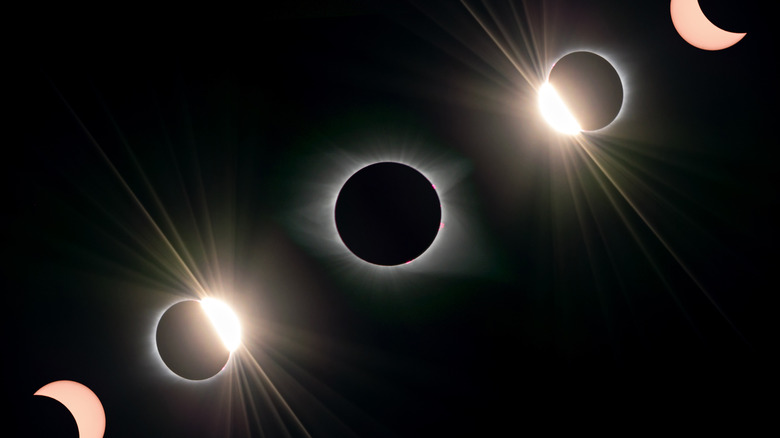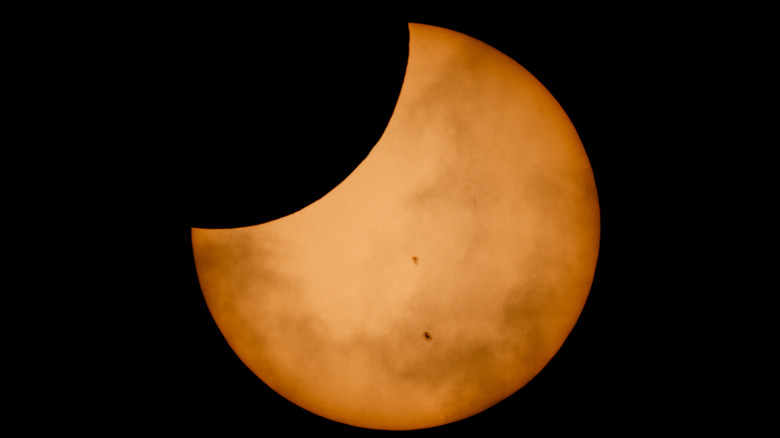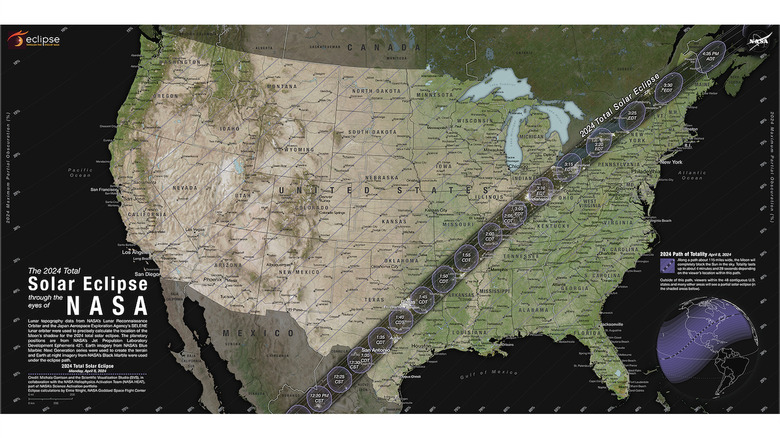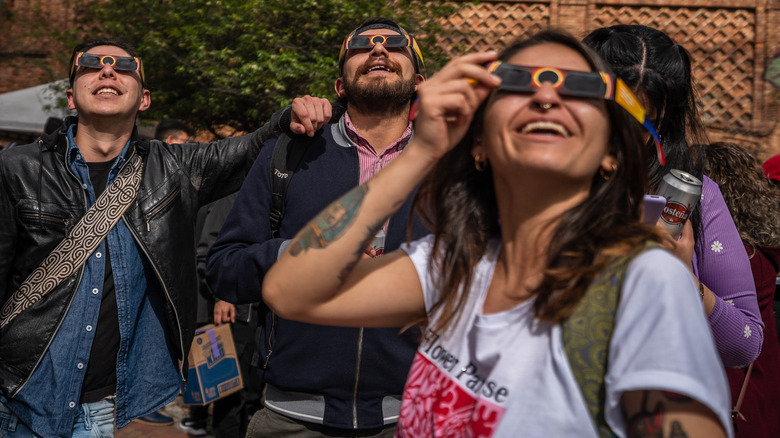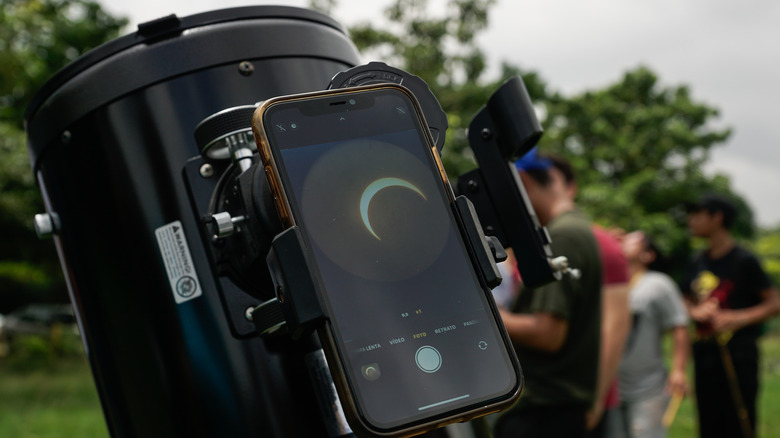You Really Don't Want To Miss This Year's Solar Eclipse. Here's Why.
On Monday, April 8, 2024, millions of people in North America will experience a total solar eclipse — when the Moon completely passes in front of the Sun and temporarily turns day into night. If you're in the path of this year's eclipse, you'll want to make sure you have a good view (and proper eye protection), and if you're not in the path, you may want to consider driving (or flying) to a location that is. That's because another total solar eclipse won't cross the contiguous United States until 2044, twenty years from now — and that's a long wait.
Experiencing a total solar eclipse is a pretty rare event — while they typically occur somewhere on the planet every 18 months, they trace a relatively narrow path across the surface, and only recur in the same place, on average, every 360 to 410 years. If you rarely or never leave the U.S., this is the only chance you'll get to see the cosmic phenomenon for another two decades, and the next one may be on the other side of the country from where you'll be at that time.
Totality — when the sun is completely obscured by the moon — only lasts for a few minutes, if not less, so you'll want to be thoroughly prepared beforehand, so you don't miss it. That means knowing exactly when and where the eclipse will occur, what to expect when it does and, most importantly, knowing how to safely view the eclipse without seriously damaging your eyes.
How does a total solar eclipse work?
There are several types of eclipse which, generally speaking, occur any time an astronomical object (or even a spacecraft) is temporarily obscured by another or its shadow. Lunar eclipses occur when the moon passes through the Earth's shadow and is darkened accordingly. Solar eclipses occur when the moon passes in between our planet and the sun, trailing its shadow across the surface of the Earth. Partial eclipses are when the angle of the moon's orbit means that it won't completely cover the sun, while annular eclipses are when the moon completely passes the sun, but appears too small in the sky to completely obscure it.
Total solar eclipses, however, put on the best show. That's when the moon completely passes across the sun, blocking out nearly all of its light to anyone in its shadow. This shadow is called the path of totality. What makes a total solar eclipse even more special is that the sun is about 400 times further away from us than the moon while also being about 400 times larger than the moon. This cosmic coincidence makes the moon and sun look to be — from the Earth's perspective — the same size. So, when the Moon passes over the sun, it blocks it perfectly, while also allowing us to see some cool aftereffects that wouldn't be possible if the moon were a lot larger.
What will you see during a total eclipse?
Once the Moon's edge starts to cross over the Sun's edge, a partial eclipse will begin. Over the course of a few hours, the Moon will continue to cross in front of the Sun, making the Sun look like a shrinking crescent of light — kind of what the phases of the Moon look like over the course of a month, except sped up. Since the Sun is extremely bright and much of it will be exposed during this phase, it's very important you never look at the Sun without proper eye protection (more on that below).
When the Moon is almost completely in front of the Sun, a phenomenon known as Baily's Beads occurs, which looks like sparkling balls of light on the edges of the Sun-Moon disk. These points of light are actually the Sun showing through the Moon's uneven surface, which includes various valleys, mountains, and craters. These only last for a very short amount of time before complete totality begins.
Once the Sun is completely obscured, you can actually look at it with your eyes, without protection. You may be able to see the sun's chromosphere, which will appear as a thin circle of pink or red around the Moon. You'll also be able to see the Sun's corona — its tumultuous outer atmosphere — which is usually obscured. This burning hydrogen gas will appear as wavy streams of white light emitting in all directions from the disk of the eclipse.
The sky will also be as dark as it would be during dawn or dusk. Because the path of totality is relatively narrow, you may be able to see light from the Earth's surface that is outside of the Moon's shadow.
Where can you see the 2024 solar eclipse?
Most of North America, including all of the contiguous U.S., will see at least a partial eclipse of the sun, while the path of totality will only occur in a narrow track across the continent, from southwest to northeast. The path will begin in Mexico, before crossing over Texas at 1:30 PM CT. It will then continue across Oklahoma, Arkansas, Missouri, Illinois, Kentucky, Indiana, Ohio, Pennsylvania, New York, Vermont, New Hampshire, and Maine, with small parts of Michigan and Tennessee also in its path. The eclipse will finish out in Canada — first in Ontario, then through New Brunswick, Prince Edward Island, Cape Breton, and, finally, exit out of Newfoundland at 5:16 PM NDT.
If you're directly in the center of the path of totality, such as in cities like Indianapolis and Buffalo — you'll experience between three and five minutes of total darkness as the moon completely obscures the sun. Cities on the inner edge of the path of totality will experience the same, but for around a minute. The closer you are to the path of totality, the more of the sun you'll see obscured, so cities just on the outside of the eclipse's track will see something like 95 percent of the sun covered. Cities much further away, like Seattle, will still have about 20 percent of the sun obscured at the height of the eclipse.
Weather plays a role in what you'll see as well. If clouds block the sun, you won't see the eclipse, though you'll still see the sky gradually get much darker as totality approaches. Many people are actively traveling to destinations inside the path of totality for a better view of this year's eclipse, including those with reliably clearer skies, like Texas.
Don't look at the sun without certified solar eclipse glasses
It should go without saying that it's a really bad idea to stare at the sun, and that's just as true during an eclipse. Even when the moon is covering 99 percent of the sun, the remaining light that giant ball of heated gas is emitting is enough to damage your eyes — perhaps even permanently. There are several ways you can safely view a solar eclipse, however, including with specialized solar eclipse glasses, which are like superpowered sunglasses that block out nearly all light and allow you to directly observe the sun, eclipse or no eclipse.
While NASA does not approve of any particular brand of solar viewers, it strongly recommends that you only use ones that adhere to the ISO 12312-2 international standard, which permits a maximum of 0.0032 percent light through — still plenty to see the sun's surface. Amazon sells many different types of solar viewers, including relatively affordable cardboard and plastic glasses and binoculars, but you need to be really careful and make sure they're certified to comply with the ISO 12312-2 international standard. You'll want to act quickly, because more and more quality solar viewers may sell out as the eclipse approaches.
Once you have solar eclipse glasses that meet the ISO 12312-2 international standard, make sure you thoroughly inspect them before using them to look at the sun. If the lenses are torn, scratched, or damaged in any way, they're useless — no unfiltered light can be allowed to reach your exposed eyes. Make sure you keep them on before and after full totality (you can remove them briefly during totality), and be very careful that children are using them properly as well.
Other ways to see the eclipse
If you're wearing solar eclipse glasses, this doesn't make it safe to observe the eclipse with a telescope or binoculars, as the lenses in those optical devices can concentrate the light and overwhelm the filters in your protective gear. However, you can still use cameras and other optical devices to look at a solar eclipse, provided you attach proper solar filters to your equipment. Using solar filters, you can even photograph and record the solar eclipse. If you're looking only through the eyepiece of equipment that has a solar filter over its lens, you don't need to wear protective eyewear.
You can also indirectly observe a solar eclipse, including in the shadows the sun may cast through trees, which will leave odd, crescent shapes while it's partially obscured by the moon. A common method to indirectly view a solar eclipse is by using a pinhole projector, which you can make with some basic arts and crafts supplies. This will project the image of the eclipsed sun onto a surface for you to safely view (you absolutely should not look through the pinhole to directly observe the sun).
When you can no longer see any sunlight through protective filters, that means the eclipse is total, and you'll have a few minutes (or less) to safely observe the obscured sun with the naked eye. The moment its light begins to appear from behind the moon again, you must quickly resume protecting your eyes.
Finally, make sure you protect the rest of your body from the sun — not just your eyes. If you're outside observing the eclipse for hours, you'll definitely want to wear sunscreen and protective clothing (like a hat) to prevent skin damage from our local star's powerful UV rays.
